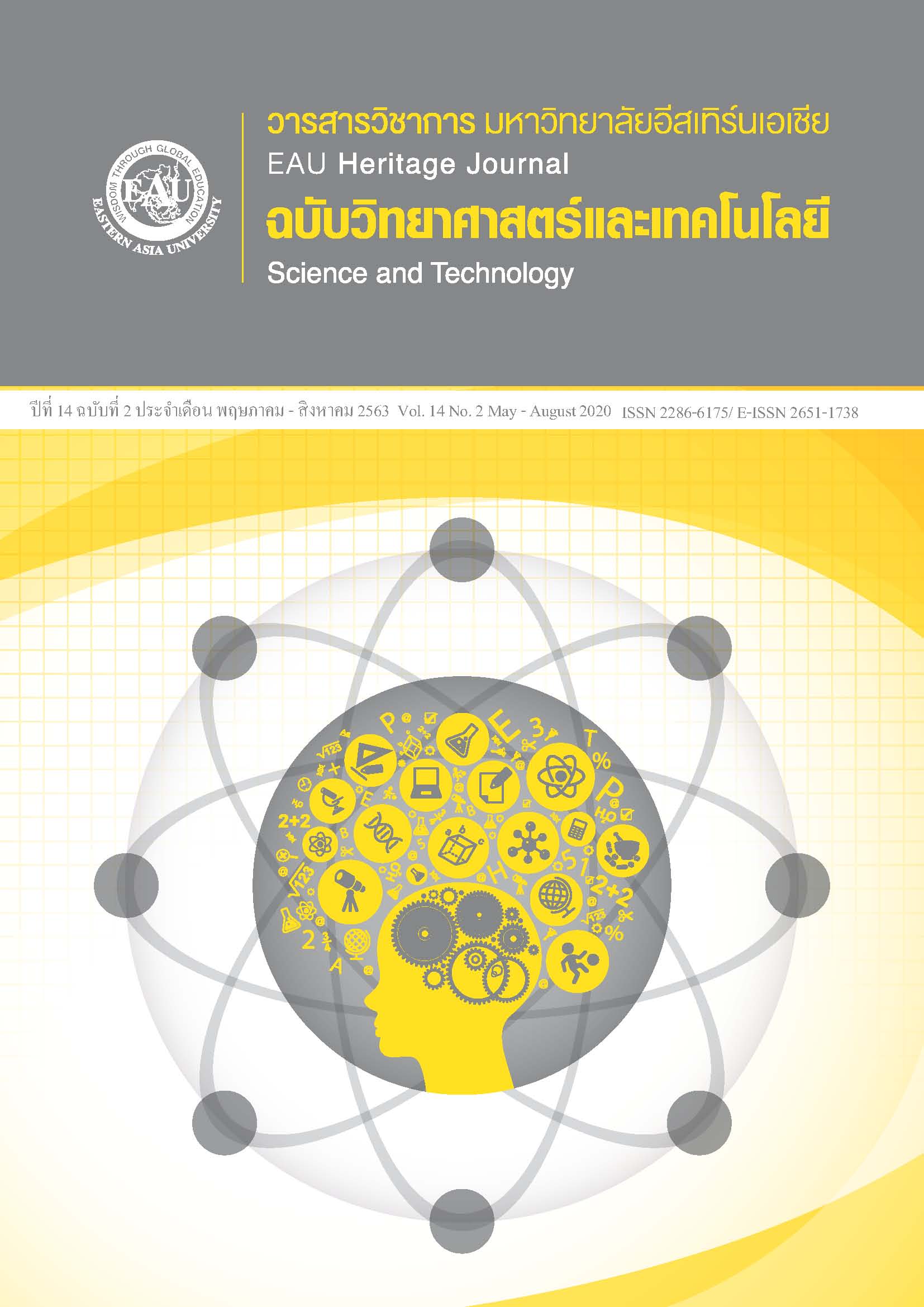Study of Toner Formulation with Anti-Oxidant Activity from Peels of Hylocereus undatus Extract
Keywords:
white dragon fruit, anti-oxidant, betalains, toner formulationAbstract
This research is a qualitative research. The purpose of the research was studied to compare anti-oxidant activity of ethanol extracts and development of toner formulation form peels of Hylocereus undatus. The extraction from peels of white dragon fruit, that have betalain groups by maceration method by using 70% and 95% ethanol, and quantitative analysis of active compounds present in crude extracted were compared to anti-oxidant activity by DPPH assay and UV-VIS spectrophotometer to measure wavelengths at 493 nanometers. After that, development to toner formulation and stability tests by freeze thaw cycles were conducted. The results found that the crude was extracted of 70% ethanol as 11.25% w/w and 95% ethanol crude was extracted as 5.48% w/w. The crude which was extracted of 70% ethanol had anti-oxidant activity more than 95% ethanol than the crude extracted in same concentrations. And, development to toner formulations and stability tests showed active compounds concentration of formulation before stability tests of formula 1, 2 and 3 were 0.63, 0.64 and 0.63 mg/mL while after stability tests of mean in formula 1, 2 and 3 were 0.21, 0.52 and 0.58 mg/mL, respectively. Therefore, the formula 3 had the highest stability and had active compounds concentration in solution of 70% ethanol as 0.55 mg/ml.
References
American Academy of Dermatology. (2017). Melasma. Retrieved from https://www.aad.org.
Azeredo, H. M. C. D. (2009). Betalains: Properties, sources, applications, and stability–a review. International Journal of Food Science & Technology, 44(12), 2365-2376.
Castellar, M. R., ObÓn, J. M., & Fernández-LÓpez, J. A. (2006). The isolation and properties of a concentrated Red-Purple Betacyanin food colourant from Opuntia stricta fruits. Journal of the Science of Food and Agriculture, 86, 122-128.
Chaovanalikit, A., Techacheewapong, P., & Tungcharernkit, P. (2010). Stability of Betacyanin form Pitaya Peel. Agricultural Science Journal, 41(Suppl 3/1), 409-412. (in Thai)
Chinmueang, W., Kijkobchai, P., Suwannatee, H. & Suntornwa, O. (2008). Betalain from two species of dragon fruit (Hylocereus undatus and Hylocereus polyrhizus). Agricultural Science Journal, 39(Supplement 3), 182-186. (in Thai)
Choo, W. S. (2015). Betalains: Application in functional foods. Bioactive Molecules in Food (pp.1-28). Retrieved from https://link.springer.com/referenceworkentry/10.1007/978-3-319-54528-8_38-2
Elbandy, M. A., & Abdelfadeil, M. G. (2008). Stability of Betalain pigments from Red Beetroot (Beta vulgaris). Journal of Food Science, 36, 49–60.
Halliwell, B. (1991). Drug antioxidant effects. A basis for drug selection?. Drugs, 42(4), 569-605.
Harivaindaran, K. V, Rebecca, O. P. S., & Chandran, S. (2008). Study of optimal temperature, pH and stability of Dragon Fruit (Hylocereus polyrhizus) peel for use as potential natural colorant. Parkistan Journal of Biological Sciences, 11(18), 2259-2263.
Herbach, K. M., Stintzing, F. C., & Carle, R. (2006). Betalain stability and degradation structural and chromatic aspects. Journal of Food Science, 71(4), R41-R46.
Hudson, B. J. (1990). Food Antioxidants. Elsevier Applied Food Science Series (pp. 253-307). Retrieved from https://www.springer.com/gp/book/9789401068246.
Kosiyajinda, S. (2001). Dragon Fruit plant economic and fruit health. Department of Agriculture: Horticulture Research Institute, Horticulture Science Society of Thailand. Retrieved from http://puechkaset.com (in Thai)
Leelapornpisit, P. (2001). Cleansing Cosmetics (Revised Edition). Bangkok: Odian Store. (in Thai)
Moreno, D. A., Garcia-Viguera, C., Gil, J. I., & Gil-Izquierdo, A. (2008). Betalains in the era of global agri-food science, technology and nutritional health. Phytochemistry Reviews, 7(2), 261-280.
Nararatwanchai, T. (2016). Anti-aging. School of Anti-Aging and Regenerative Medicine, Mae Fah Luang University. Retrieved from http://anti-aging.mfu.ac.th (in Thai)
Nurliyana, R., Syed Zahir, I., Suleiman, M., Aisyah, M. R., & Rahim, K. (2010). Antioxidant study of Pulps and Peels of Dragon Fruits: A comparative study. International Food Research Journal, 17(2), 367-375.
O-Chongpian, P., Pimmpa, P. & Jantrawut, P. (2017). Development of Eyes Mask Containing Dragon Fruit peel extract. Journal of Agriculture, 33(3), 415-425. (in Thai)
Phasipol, T. (2014). Betalain: Extraction and Analysis. KKU Science Journal. 42(4), 718-729. Retrieved from http://scijournal.kku.ac.th/files/Vol_42_No_4_P_718-729.pdf (in Thai)
Priatni, S. & Pradita, A. (2015). Stability study of Betacyanin extract from Red Dragon Fruit (Hylocereus polyrhizus) peels. Procedia Chemistry, 16, 438-444.
Rujisawang, P., & Singpraseart, S. (2018). The development of Toner formulation with Anti-Oxidant activity from peels of Hylocereus undatus extract. (Doctoral dissertation). Eastern Asia University. Pathum Thani. (in Thai)
Stinzing, F. C., & Carle, R. (2004). Functional properties of Anthocyanins and Betalains in plants, food and in human nutrition. Trends in Food Science Technology, 15, 19-38.
Strack, D., Vogt, T. & Schliemann, W. (2003). Recent advances in Betalain research. Phytochemistry, 62(3), 247-269.
Thammawong, K. & Jaiwut, P. (2014). Development of Natural Colorant from Dragon Fruit Peel for cosmetic application, School of Cosmetic Science, Mae Fah Luang University. Retrieved from http://postgrads.mfu.ac.th (in Thai)
Teng-Umnuay, P. (2013). Anti-aging medicine (Master of Science Program in Anti-Aging and Regenerative Medicine). Dhurakij Pundit University, Bangkok. Retrieved from http://tlaa.org. (in Thai)
Tonglim, J., & Suttisansanee, U. (2016). Potential anti-aging from tea, Institute of Nutrition, Mahidol University. Retrieved from http://www.inmu.mahidol.ac.th (in Thai)
Wee, S. C., & Wee, K. Y. (2011). Antioxidant properties of two species of Hylocereus fruits. Advances in Applied Science Research, 2(3), 418-425.
Wessagowit, V. (2014). Wrinkle. Retrieved from http://inderm.go.th (in Thai)







